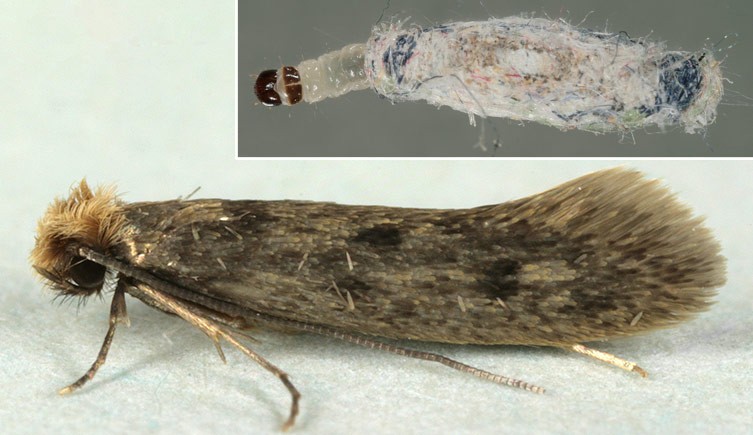Create a list of articles to read later. You will be able to access your list from any article in Discover.
You don't have any saved articles.


The adult forms of: left - the common clothes moth (© Olaf Leillinger, CC BY-SA 2.5, via Wikimedia Commons); right - the case-bearing clothes moth (© Malcolm Storey, CC BY-NC-SA 4.0, via BioImages)
The two moths most commonly found in UK homes doing damage to natural fibres are the common clothes moth (Tineola bisselliella) and the case-bearing clothes moth (Tinea pellionella). It is the immature larvae, rather than the adult moths, that cause the damage to natural fibres such as woollen clothing, upholstery, carpets and furs.
Both moths have a similar life cycle and infestations can be controlled using the same approach.
The clothes moths belong to a family of the Lepidoptera known as the Tineidae - the fungus moths, which mainly feed on detritus, fungi and lichens. The larvae of clothes moths are adapted to feed on keratin, a protein found in natural fibres. They can be a significant pest of home furnishings and stored fabrics.
In recent years, clothes moths infestations have become more common. The common clothes moth is more frequently encountered than the case-bearing clothes moth.
Adults have golden coloured wings which are held back behind the body. Both fore and hind wings have a fringe of hairs along the margins, no pattern and a wingspan of 12-17mm. The head is coated with reddish hairs. The larvae can reach 13mm and are white with a hardened, brown head capsule and no ocelli (simple eyes).

Main image: the adult common clothes moth (© Olaf Leillinger, CC BY-SA 2.5, via Wikimedia Commons). Inset, the larval form on felt - note the strands (© Malcolm Storey, CC BY-NC-SA 4.0, via BioImages)
Adults have silver grey-brown coloured wings which are held roof like behind the body. Both fore and hind wings have a fringe of hairs along the margins. The forewings are brown with one large dark spot and two smaller dark spots, although these often rub off on older specimens. This moth has a wingspan of 9-16mm. The head is coated with grey hairs.
Larvae can reach 12mm and are white with a hardened, brown head capsule and one ocelli (simple eyes). The case-bearing moth derives its name from the tunnel-like cases that the larvae spin from silk and surrounding materials. The larvae carry the cases with them as they grow, for camouflage and protectection.

Main image: the adult case-bearing clothes moth (© Malcolm Storey, CC BY-NC-SA 4.0, via BioImages). Inset, the larval form emerging from the case it has made from old walking sock fibres (© Malcolm Storey, CC BY-NC-SA 4.0, via BioImages)
Both moths are now found in many parts of the world. They are often found as indoor insects, inhabiting upholstery, clothing and carpets. Clothes moths prefer low light levels and dirty fabrics, such as carpets and rugs, which contain essential nutrients and moisture for growth.
Females lay eggs within natural fibres, which hatch between 4-10 days in summer months and up to three weeks in colder weather.
Common clothes moth larvae spin tunnels of silk and nearby materials which provide camouflage during the day, these can become dense mats if larvae are gregarious. At night the larvae emerge to feed, slowly damaging the materials they inhabit.
Case-bearing clothes moth larvae carry their spun cases with them, for camouflage and protection.
The larvae have five instar developmental stages and can take from one month to two years to fully develop, depending on conditions. They then spin cocoons and pupate for 10-50 days, before hatching out as an adult moth. Adults have atrophied mouth parts so do not feed and will often scramble across fabrics, rather than fly, as they try to find a mate. Between one-two days after emergence, they mate and lay eggs.
Adults do not feed, obtaining all nutrients needed for their final life stage during larval growth, and cause no damage to fabrics. Larvae can cause serious damage to tapestries, carpets and clothing, leaving trails across woollen garments and removing hair from fur coats at the base.
Traditionally chemicals were used to treat clothing, particularly mothballs which emit toxic fumes, kill larvae and prevent infestation. Nowadays natural control is favoured, for example introducing cedar oil or bags of dried lavender to wardrobes is thought to prevent infestation.
Freezing to -8°C for several days or heating fabric to temperatures of 49°C for over 30 minutes kills all life stages and can be accomplished with home appliances, such as a freezer or washing machine. Dry cleaning destroys pests and removes the moisture and dirt from fabric essential to larval growth. Clothing can be stored in air tight bags and containers to prevent infestation. For carpets and upholstery, vacuuming helps to eradicate infestations.
Pyethrin insecticides can be sprayed on fabrics which cannot be treated by freezing or cleaning, these instantly destroy moths and do not leave toxic residues like many traditional chemicals. Moth traps, adhesive boxes which emit artificial pheromones to attract adult moths, can be checked to monitor infestation.
Download the information sheet on the common clothes moth as a PDF (373KB)
Download the information sheet on the case-bearing clothes moth as a PDF (319KB)
Elsewhere on the internet: